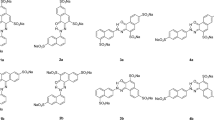Abstract
Fluorescein dye was prepared and characterized on the basis of microanalytical methods, FTIR, NMR and UV–visible spectroscopy in order to ensure its purity. Thermoanalytical study by TG, DTA and DTG was conducted in air as well as in inert atmosphere to determine the mode of decomposition and stability. The dye follows two-step and three-step decomposition pattern in air and nitrogen, respectively. The first stage of decomposition in both environments yields carbon monoxide and oxygen, whereas carbon monoxide and acetylene are the common products of second-stage decomposition except anthracene which is released only in air. The third step evolves ketene and acetylene under inert condition and the residue (observed at 1133 K) is a highly conjugated cyclic system. Char is the only residue which is identified at the end of decomposition under air after 893 K. The intermediates formed during the decomposition processes were also investigated. A possible mechanism of the thermal decomposition is proposed depending on pyrolysis, MS and IR spectral data.





Similar content being viewed by others
References
Haugland RP. Handbook of fluorescent probes and research products. 9th ed. Eugene: Molecular Probes Inc.; 2002.
Urano Y, Kamiya M, Kanda K, Ueno T, Hirose K, Nagano T. Evolution of fluorescein as a platform for finely tunable fluorescence probes. J Am Chem Soc. 2005;127(13):4888–94.
Yao H, Steill JD, Oomens J, Jockusch RA. Infrared multiple photon dissociation action spectroscopy and computational studies of mass-selected gas-phase fluorescein and 2′,7′-dichlorofluorescein ions. J Phys Chem A. 2011;115(34):9739–47.
Aschi M, D’Archivio AA, Fontana A, Formiglio A. Physicochemical properties of fluorescent probes: experimental and computational determination of the overlapping pKa values of carboxyfluorescein. J Org Chem. 2008;73(9):3411–7.
Lebed AV, Biryukov AV, Mchedlov-Petrossyan NO. A quantum-chemical study of tautomeric equilibria of fluorescein dyes in DMSO. Chem Heterocycl Compd. 2014;50(3):336–48.
Maggs DJ, Miller PE, Ofri Ron, editors. Slatter’s fundamentals of veterinary ophthalmology. 4th ed. Philadelphia: Saunders Elsevier; 2008.
Crompton TR. Determination of organic compounds in natural and treated waters. 1st ed. London: E & FN Spon (An imprint of the Taylor and Francis group), New Fetter Lane; 2000.
Noga EJ, Udomkusonsri P. Fluorescein: a rapid, sensitive, nonlethal method for detecting skin ulceration in fish. Vet Pathol. 2002;39(6):726–31.
Duarte JF. Tunable laser applications. Boca Raton: CRC Press; 2009. p. 227–35.
Demtröder W. Laser spectroscopy. 3rd ed. Berlin: Springer; 2003.
Arshad M, Masud K, Arif M, Rehman S, Saeed A, Zaidi JH. Characterization of poly(methyl methacrylate)-tin (IV) chloride blend by TG-DTG-DTA, IR and pyrolysis-GC-MS techniques. Bull Korean Chem Soc. 2011;32(9):3295–305. doi:10.5012/bkcs.2011.32.9.3295.
Sun WC, Gee KR, Klaubert DH, Haugland RP. Synthesis of fluorinated fluoresceins. J Org Chem. 1997;62(19):6469–75.
Burgess K, Ueno Y, Jiao GS. Preparation of 5- and 6-carboxyfluorescein. Synthesis. 2004;15:2591–3.
The Sadtler Standard Spectra. Philadelphia PA 5: Sadtler Research Laboratories; 1974.
Smith AL. Applied infrared spectroscopy fundamentals, techniques and analytical problem-solving. New York: Wiley; 1979. p. 297, 308.
Arshad M, Masud K, Arif M, Saeed A. Mechanistic study of thermal behaviour of poly(vinyl acetate) blended with aluminum tribromide—an investigation aided by IR and Py-GC-MS techniques. J Therm Anal Calorim. 2014;115(2):759–69. doi:10.1007/s10973-013-3222-0.
Arshad M. Pyrolytical sifting of poly(styrene-co-methyl methacrylate) blended with stannic chloride: an investigation engaging IR and Py-GC-MS techniques. Int Res J Pure Appl Chem. 2015;9(1):1–17. doi:10.9734/IRJPAC/2015/18689.
Lizarraga E, Zabaleta C, Palop JA. Thermal behavior of quinoxaline 1,4-di-N-oxide derivatives. J Therm Anal Calorim. 2017;127(2):1655–61.
Ma Q, Lu H, Liao L, Chen Y, Cheng B, Fan G, Huang J. Synthesis and thermal decomposition performance of 3, 6, 7-triamino-7H-s-triazolo[5,1-c]-s-triazole. J Therm Anal Calorim. 2017;127(3):2517–29.
Lai M, Ji X, Tao T, Shan Y, Liu P, Zhao M. Synthesis and pyrolysis of two flavor precursors of oct-1-en-3-yl methylprazinecarboxylates. J Therm Anal Calorim. 2017;128(3):1627–38.
Acknowledgements
The authors are indebted to PINSTECH, Islamabad, Pakistan, for the technical support and the provision of scientific facilities. Thanks are due to Muhammad Gulzar, MD, PINSTECH, for performing thermoanalytical measurements of the samples. Chemistry Department, Quaid-i-Azam University, Islamabad, is acknowledged for providing the instrumental facilities of FTIR and NMR. Finally, the authors would like to express their appreciation for Nadeen Ahmad and Muhammad Adeel Khattak (CD;SA-II) for undertaking the arduous tasks of drawing figures and composing the manuscript.
Author information
Authors and Affiliations
Corresponding author
Rights and permissions
About this article
Cite this article
Arshad, M., Masud, K., Saeed, A. et al. Thermogravimetric and differential thermal analyses of fluorescein dye in inert and static air atmosphere. J Therm Anal Calorim 131, 1385–1390 (2018). https://doi.org/10.1007/s10973-017-6568-x
Received:
Accepted:
Published:
Issue Date:
DOI: https://doi.org/10.1007/s10973-017-6568-x




